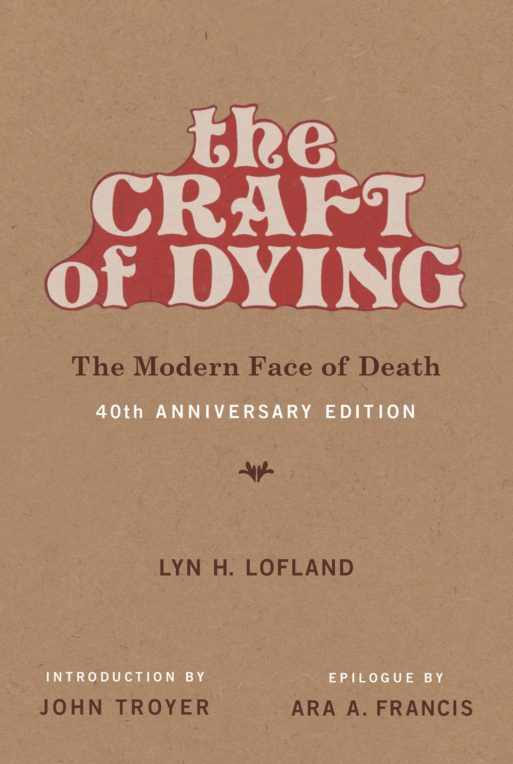 Initially published in 1978, the 40th anniversary edition of “The Craft of Dying” by Lyn H. Lofland remains a relevant resource today. The book is a thoughtful exploration of sociological perspectives on the concept of a happy death or peaceful passings and afterlife. Lofland identifies, critiques, and theorizes a surge of 1970s death social movements that grew out of these notions. Their legacies continue to influence both societal perception and legislation on dying 40 years later
Initially published in 1978, the 40th anniversary edition of “The Craft of Dying” by Lyn H. Lofland remains a relevant resource today. The book is a thoughtful exploration of sociological perspectives on the concept of a happy death or peaceful passings and afterlife. Lofland identifies, critiques, and theorizes a surge of 1970s death social movements that grew out of these notions. Their legacies continue to influence both societal perception and legislation on dying 40 years later
“The Craft of Dying” explores a collection of the myriad philosophies on death that surfaced in the 70s. Magazine and newspaper articles, books and television depicted that death could be a happy event. Renowned psychiatrist, Elizabeth Kubler-Ross pioneered the five states of grief during this decade. We also perfected ways in which we could fend off death for many terminal conditions.

Publications about death surged across media platforms in the mid 1970s fueling society’s fascination with the subject.
Various social movements grew out of our achievements, observations, and fascination with death. Dying then became somewhat bureaucratized and secularized. The accumulative views on where we die, how we die, and why we die ultimately paved the way for significant legislative initiatives and outcomes.
Many of these decades old milestones persist in the 21st century. “The Death Acceptance Movement” spurred palliative and hospice care laws to increase quality of life for those with terminal illness. “The Death with Dignity Movement” ultimately propelled Oregon to become the first state to legalize assisted suicide in 1994. And the “Natural Death Movement” is responsible for our ability to create a legal living will, or advanced directive, outlining when we want life-sustaining medical interventions used or not.
Lofland examines these social compositions of death on a more personal level in “The Craft of Dying.” She outlines an individual construction of death. She proposes that people may choose to play out their dying process as they please: “They must engage in a kind of ‘role enterprise,’ constructing for themselves the particular combination of components that will make up their identities as dying persons.”
Constructions of death are created utilizing the following criteria:
Life Space: The portion of self the someone wishes to dedicate to their dying role. How much portion of self will they allow their dying role to encompass?
Population: How much of the dying role the actor chooses to play out alone or with others who are also playing it out. Is there a desire to share the experience with others who are also dying or not?
Knowledge: the degree to which information about one’s admission to the dying role is shared with others. Is the information shared with only the doctor, or the family, or with anyone and everyone?
Stance: the character or emotional tone or personal philosophy that is expressed in the role. The diversity of demeanor; the elusive and expansive dimension of choice in the creation of the dying role.
While inspiring dying persons to shape their own role, Lofland acknowledges limits to their freedoms to do so. Our secular and bureaucratic society is challenging; hence a dying person may lack control to execute all wishes. For instance, one cannot choose to die solo when hospitalized. Or, a desire to share the knowledge with others in a larger circle may not be feasible. Ultimately, four external circumstances can skew any construction of death at any time: the disease process, the social organization and culture of medical practice, available resources, and surrounding others, which can highly influence the first three externals.

A “happy death” is a common goal that only society itself can continue to strive to manifest.
Although expanded resources to health care for terminally ill are well meaning, Lofland notes these initiatives are not enough to satisfy criteria for a “happy death.” Nor, is fine tuning current laws or regulations enough to bolster its chances of occurring against the backdrop of today’s realities.
“The Craft of Dying” encourages us to closely examine death social movements’ historical relationships to race, class, gender, and sexuality. From there, perhaps we might embrace an emergent ideology of death and spur a new movement in more modern times. One can only hope that we might achieve a collective goal to fully allow the execution of a “happy death” for anyone and everyone who is dying.

 The Craft of Dying: The Modern Face of Death by Lyn H. Lofland
The Craft of Dying: The Modern Face of Death by Lyn H. Lofland


 “Songbird” by Fleetwood Mac
“Songbird” by Fleetwood Mac
 First the Wealth Gap, Now the U.S. Has a Growing Health Gap
First the Wealth Gap, Now the U.S. Has a Growing Health Gap
 How to Comfort A Dying Loved One
How to Comfort A Dying Loved One














